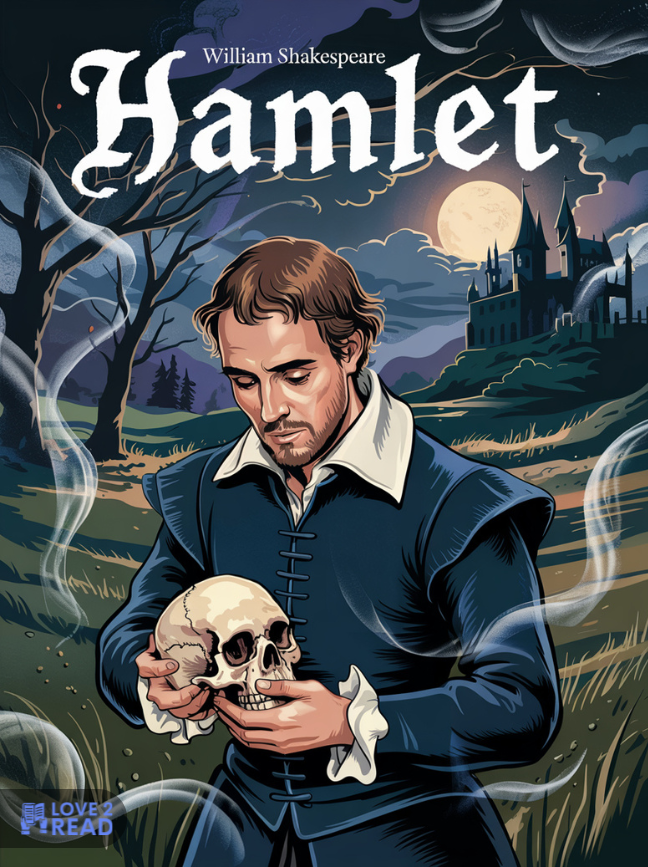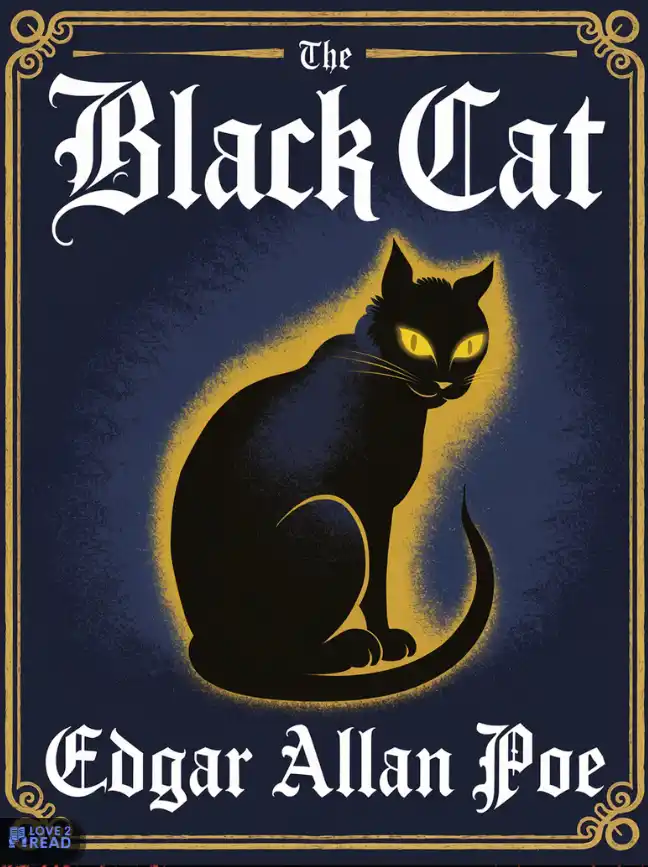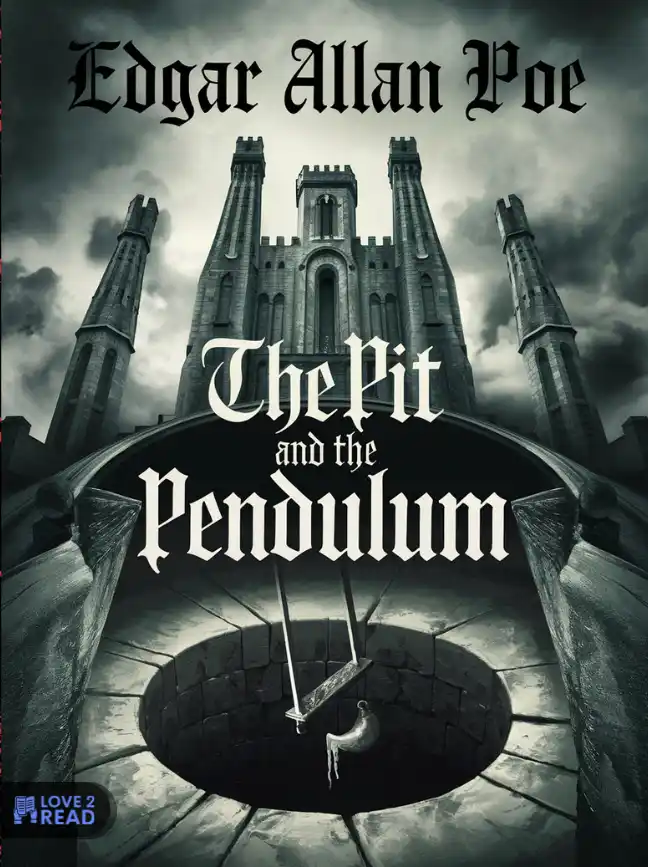The preface to this translation of Hamlet contains an assertion which must be corrected. We refer to the conjecture, cited as almost certain, which attributes to Thomas Kyd a tragedy written, it is said, six or seven years before that of Shakespeare, on the subject of Hamlet . Here is the origin of this conjecture.
Until 1825, the oldest surviving edition of Shakespeare’s Hamlet was a quarto, dated 1604, whose title gave the play as “printed again and enlarged almost double, according to the true and perfect text.” It was believed that the earlier edition, indicated by this very title, must have been from 1602, because the play was found registered in the bookshop registers on July 26, 1602, in the name of the printer James Roberts. It was also believed that the play had been written in 1600, because of the passage in the second act (scene II), where it is said that the actors’ impediment, that is to say, the necessity they found themselves having to form a traveling troupe, comes from the recent innovation; Now, this innovation cannot be the order issued by the Privy Council on June 22, 1600, to reduce the number of theatres to two, because this order favored Shakespeare’s troupe instead of harming it; and moreover it was never executed, although renewed in even stronger terms the following year. The fact to which the above-mentioned passage refers is therefore, on the contrary, the permission granted, in 1600, to the children of the chapel of Saint-Paul, who then resumed with a new vogue their performances interrupted since 1591.
Thus, 1604, the date of the oldest preserved edition; 1602 , the probable date of the first edition; 1600, the obvious date of the composition of the play; such was, in 1825, the chronology of Shakespeare’s Hamlet . And yet, several documents prior to the year 1600 spoke of a tragedy of Hamlet . Thomas Lodge, in 1596, to give the idea of extreme pallor, said: “pale as the mask of that spectre which cried so miserably, in the theatre: Hamlet, avenge me!” A troupe of actors had, in 1594, played a Hamlet at Newington. Thomas Nash, in 1589, in an epistle which serves as a preface to Greene’s Arcadia , wrote the following: “There is a species of vagabond journeymen today who go through all trades without making their way by any, and who, leaving the trade of law for which they were born, give themselves to the attempts of art, they who could scarcely put a verse into Latin, if they had need of it; but Seneca translated into English, read by candlelight, furnishes a good many good sentences, as: blood is a beggar , and so on; and if you entreat him well, on a cold morning, he will give you full Hamlets , I mean full handfuls of tragic speeches.”
Between these two series of facts, some of which fixed the composition of Shakspeare’s Hamlet at the year 1600 , while others showed a Hamlet performed and criticized as early as 1589, what reconciliation could be found? The only one that should have seemed possible was this very conjecture by which Malone supposed a Hamlet anterior to that of Shakspeare; and if he attributed it to Thomas Kyd, it was perhaps because of the resemblances that we have noted above between Hamlet and the Spanish Tragedy (see page 206, note); perhaps he thought that Kyd, being known to have taken some steps towards the conception of Hamlet , had more claims than any other to the supposed honor of having approached it completely and of having provided Shakspeare, no longer only with a few traits of character and the bold model of a single scene, but with the data and the plan of the entire play.
Malone’s conjecture suddenly lost all credibility when, in 1825, a copy of Shakespeare’s Hamlet was found , which differed in date and text from the Hamlet previously known. The date was only a year earlier than that of the edition initially considered to be the oldest. But if the date only went back to 1603, the text went back to at least 1591; indeed, in the second scene of the second act, in the passage already mentioned where it concerns the itinerant actors, one could note an important difference: in the 1603 text, the allusion is to the reopening of the Children of St. Paul’s Theatre, which took place in the year 1600; in the 1603 text, the allusion is to the first period of the performances of this children’s troupe, which had begun in 1584 and were banned in 1591. Here, then, is Shakspeare’s Hamlet composed at least in 1591, that is to say nine years earlier than was believed. And as it seems, moreover, that the jokes quoted above from Thomas Nash apply very exactly to Shakspeare; as Nash was, with Marlowe, the author of that tragedy of Dido which is parodied in Hamlet , and consequently had some grudge to satisfy against Shakspeare; as it is certain that Shakspeare had not learned much Latin in his youth; as he appears on the contrary to have been singularly versed in the knowledge of law, of which he very often uses the most subtle terms, we must fix the date of Shakespeare’s Hamlet according to the date of Nash’s mockery, that is to say in 1589 at the latest.
We know, moreover, from an official document found in the archives of Lord Ellesmere, that Shakspeare, in November 1589, was one of the partners of the Blackfriars Theatre and had a share in the profits; Harmlet , even if only in its infancy, could well have earned him these advantages; and that Shakspeare owed, in fact, to the first Hamlet , his first admission among the partners of the theatre, is a fairly probable hypothesis. See, in the revised and developed Hamlet , in the third act, in the second scene, after the performance inserted in the drama, what the hero says to his friend: “Do you not think that a theatrical coup like this could make me a companion in a troupe of actors? – Half a share, replies Horatio. – Full share, I tell you, resumes Hamlet.” The first Hamlet contains nothing of this passage, and are we not naturally led to believe that Shakspeare, in adding this fragment of dialogue, was thinking of himself, that he wanted to establish before the public the dramatic value of a highly exploited incident, and that, through the mouth of his hero, in the name of the success of his work, he was claiming, in the profits of his companions, the full share of which only half would have been granted to him for the first Hamlet ? It is remarkable, in fact, that, according to the document found at Lord Ellesmere’s, Shakspeare, in 1589, was still ranked only one of the last among the associates of Blackfriars, while we find him named second in the royal license granted to his troupe in 1603.
But even if the quarto discovered in 1825 had not given us this first Hamlet which began Shakespeare’s fortune, even if neither Lodge nor Nash had led us to suspect its existence, there is, among the curiosities of old English theatre, a play which should have been enough, in our opinion, to make us believe that Shakespeare’s Hamlet , at least in its draft form, was performed and known in 1589.
It is a drama entitled: Avis aux belles femmes , whose plot revolves around the murder of a London merchant, committed in 1573 by his wife and his wife’s lover. It is proven, by the very text of the drama, that it was written in 1589. Let us note, in passing, that, towards the end of the play, one of the characters tells, to demonstrate the usefulness of the theater, this same story to which Hamlet alludes in his last monologue of the second act and which we have reported in a note at this point (p. 491); but whether or not we attach any value to this perhaps fortuitous coincidence, here is another passage, much more important in our eyes, from this old drama; It is a prologue in which tragedy, comedy and history are personified, fighting for superiority and the right to occupy the stage, and here is the picture of tragic spectacles as the Comedy retraces it: “A damned tyrant, to obtain the crown, poisons, stabs, cuts throats; a nasty, weeping specter, wrapped in a dirty canvas or in a leather coat, enters whining like a half-slaughtered pig, and cries vindicta! vengeance, vengeance! And when he appears, we see a little resin blazing, like a little smoke coming out of a pipe, or like a child’s firecracker. And at the end, there are two or three of them who pierce each other, with needles for threading laces. Isn’t that a beautiful display, a majestic spectacle?” Is this not, obviously, we will say in our turn, the grotesque caricature of a representation of Hamlet and of the petty staging which spoiled the most supernatural or most murderous scenes? When we see in an indication of the first Hamlet , in the third act, the ghost appearing, with all due respect, in a nightshirt, at the very moment when his son contemplates him and describes him with the most respectful terror, or we can easily imagine that this poor ghost could well have had, in the first act, on the platform of Elsinore, only a leather coat to represent his famous armor known to the Poles and a resin torch to play some reflection of “these sulfurous and torturing flames” where he will be obliged to return. We also understand that the accumulated deaths of the denouement gave laughter to the laughers; comedy has always reproached tragedy for its arsenal of weapons without points and its procession of false corpses. Either we are very much mistaken, or all the features we have cited from this prologue to the old English drama are so many traces of Shakespeare’s Hamlet , and contribute to assigning it the year 1589 as its date.
Shakspeare was born in 1564; it would therefore have been at the age of twenty-five that he wrote his first Hamlet . Is not such a work, conceived by such a young man, already the most singular example of the precocity of genius? Not all of Shakspeare’s admirers, however, are satisfied, and there are some who would like to fix the date of the first Hamlet at 1584. Two arguments persuade them to do so. It is said, in the first Hamlet , that the nomadic actors became nomads because “novelty prevails,” and that the greater part of the public who came to their houses turned to private theaters “and to the amusements of children;” now, it was in 1584 that the choirboys of St. Paul’s Chapel began to act, and that their amusements were, it is said, a novelty. It has also been noted that in 1584 Shakspeare had twin children, a daughter named Judith and a son named Hamlet; now, this last name has seemed to allow us to suppose that Shakspeare already had his great Danish drama in mind, and that perhaps even, feeling himself prey to misery and fatality, he had wanted, so to speak, to baptize himself in advance as a tragic avenger in the person of his newborn son. These arguments can be answered by more than one objection.
Let us first examine the sentence relating to the nomadic actors. It proves, as we have said above, that the first Hamlet cannot be later than 1591; that is what it proves, and nothing more; it indicates a period whose limit is known, not a precise fact whose special date is known. It is not to the debut of the children of Saint-Paul, but to their already decided success that this sentence alludes; for the old troupe to renounce its accustomed stay, it was not enough for a novelty to appear near it: it was necessary for the novelty to prevail over it and take away the greater part of the public.—But in 1589, it will be said, the performances of the children of Saint-Paul had already lasted for five years, and their very success could no longer pass for the vogue of a novelty.—In the eyes of the public, no, perhaps; but in the eyes of the old troupe, assuredly yes. How long, for anyone who has succeeded, do those who succeed after him not remain intruders! How long, in France and in our century, have we not continued to call “poets of the new school” those who had already passed to the rank of models! Hernani , for many years, although being the law for some, was still for many others only a fashionable novelty. But to return to the first Hamlet and to the sentence which concerns us, it is singular that one seeks there a precise allusion to the beginnings of the children of Saint-Paul, if one notes that Shakespeare speaks at the same time of private theaters. When the children of Saint-Paul began their performances, it was already many years since the rich lords of the court had become accustomed to enlisting troupes of actors from among their servants; Elizabeth had only recently ascended the throne when Lord Leicester set the example, and before 1584 he had already had ten imitators. It is to the whole of these troublesome rivalries that Shakspeare, in the first Hamlet , attributes the defections of the public; there is no exact chronology to be drawn from a sentence in which facts spaced over more than ten years are brought together; the troupe in which Shakspeare was engaged dated from 1575, and it is because of its long and uninterrupted existence that this troupe, through the voice of its poet, treated all its rivals as newcomers. Thus, whether we consider this sentence from the first Hamlet in itself , or compare it with the corresponding passage from the second Hamlet , all that can be concluded is that the second Hamlet was written after 1600, and the first before 1591; but it in no way proves that the first Hamlet dates from 1584.
But Shakespeare, in 1584, gave his son the name Hamlet! Yes, or at least that of Hamnet; so mentions the civil status register of Stratford-upon-Avon. But Hamlet or Hamnet, it matters little: we see, in various acts, the two names commonly confused; only, how can we see in this baptismal certificate the slightest trace of dark intentions or poetic preoccupations? The child received his name quite simply from his godfather, Mr. Hamnet or Hamlet Sadler, as his twin sister received hers from Mrs. Judith Sadler, her godmother; and if Amleth, the hero of Danish legend and the Belleforest stories, has anything to do with all this, it is not that he served as a patron to Shakespeare’s son: quite evidently, on the contrary, the Prince of Denmark was born for the stage and was called Hamlet only after the obscure child of Stratford-upon-Avon, from whom he borrowed the English spelling of the name by which he is forever known. Moreover, the reader will find at the end of this volume an Appendix devoted to the comparison of the different texts of Hamlet , and this more general study will, we hope, provide him with some further reasons to conclude as we have on the point of the special debate to which we have had to confine ourselves here.





